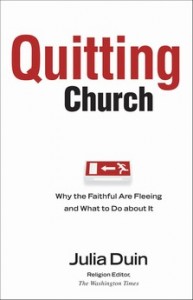 Duin, Julia. Quitting Church: Why the Faithful Are Fleeing and What to Do about it. Baker Books, 2008. ISBN: 978-0-8010-6823-2.
Duin, Julia. Quitting Church: Why the Faithful Are Fleeing and What to Do about it. Baker Books, 2008. ISBN: 978-0-8010-6823-2.
Meet the Author
Julia Duin is the religion editor for the Washington Times. She has a master’s degree in religion from Trinity School for Ministry (an Episcopal seminary) and has covered the beat for three decades. Duin has won numerous awards and been nominated twice for a Pulitzer.
“It’s no secret that the percentage of Americans in church on any given Sunday is dropping fast” (p.11). She opens with a chapter that overviews why people leave, focuses each of the next eight chapters around a single reason for the decline, and concludes with a chapter focused on bringing them back. The evidence presented in each chapter is significant and is a blend of her own experiences and conversations with data from recent studies, articles and books.
So What?
The book provides far more substantive data about the problem than the solution. It is important for church leaders and for all American Protestant Christians to not only be aware of the problem, but also begin working toward helpful solutions.
The problem includes a need to adjust to the twenty-first century, the departure of singles over age 35, women who are fed up with a faith that does not treat them as equals with men, and charismatics who are finding the well empty. Additional contributing factors to this problem include:
- The church is irrelevant. ” . . . people are bored witless at church . . . What’s preached and talked about is irrelevant to their daily existence in the twenty-first century” (p.32).
- The church isn’t the community we expect. “One of the top reasons people give for leaving their church is loneliness: the feeling, especially in large congregations that no one knows or cares whether they are there” (p. 50).
- There is not much solid teaching to help disciples mature in their faith. “People who are not learning new insights at church will go shopping elsewhere” (p.107).
- Pastors fail to lead. “Barna says most pastors are not leaders. They may be teachers or shepherds, but they do not lead – that is, motivate the flock and lead institutional change” (p.128).
The solution is far less clear. Local congregations must heed these warnings. Pastors and lay leaders must be proactive not reactive when looking both to open the front door to welcome new guests and members and to close the back door and keep current members for leaving. Congregational strategic plans must be what they claim to be: strategic. Within those comprehensive plans there should be practical steps to address these real concerns. Will individual leaders and leadership bodies do the important work of honest evaluation? Will they make the changes needed or continue to decline and die? (Duin suggests the later is likely: “. . . back to local churches, many of which are not about to change. They would prefer to die first and many will slowly fade into the sunset” – p. 178).
